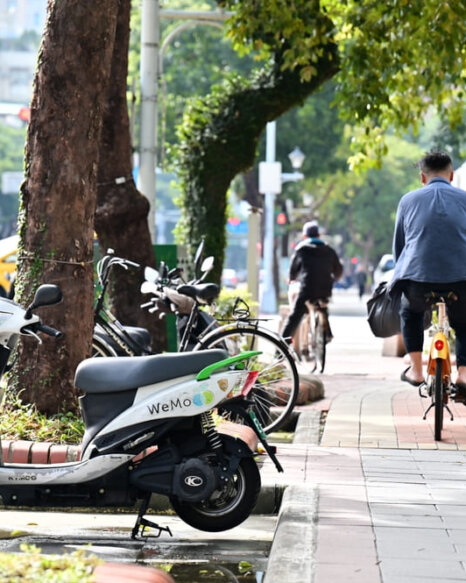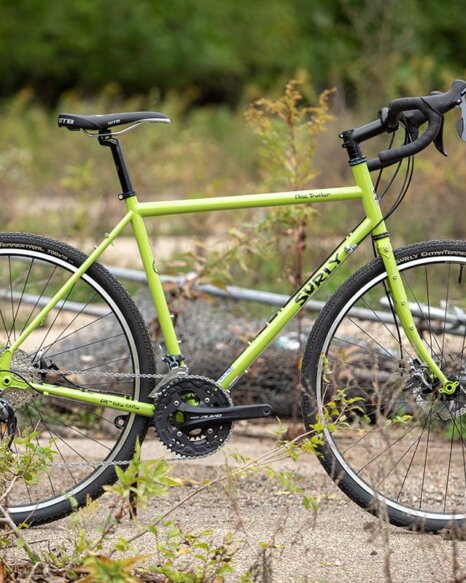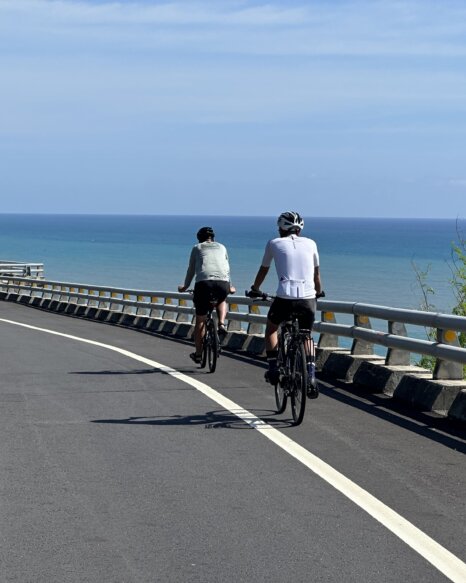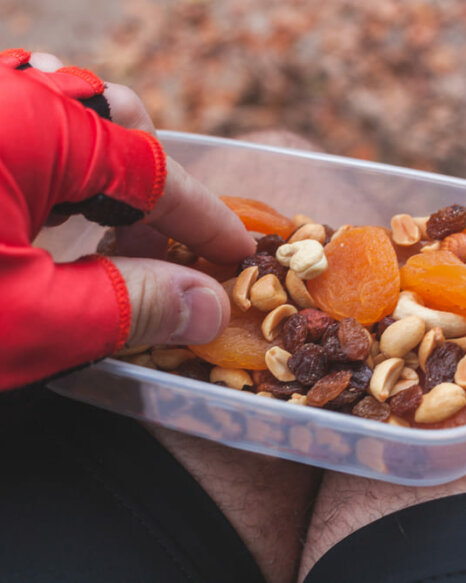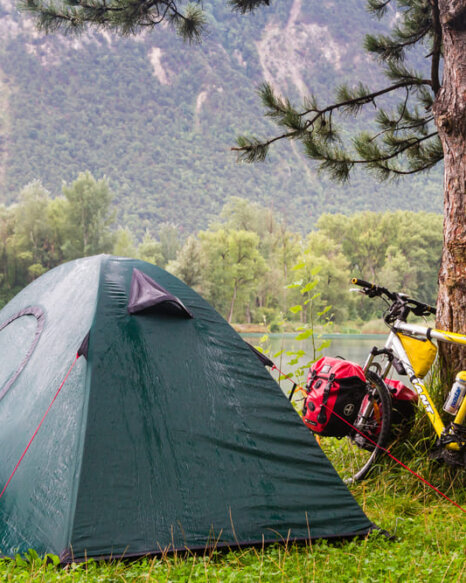
Taiwan weather plays a major role in planning your cycling trip, especially if it’s your first time riding on the island. From sudden rain showers to intense summer heat, Taiwan’s climate shifts dramatically between seasons and regions.
Understanding Taiwan weather will help you pick the right routes, pack accordingly, and stay safe while enjoying stunning coastal roads, mountain climbs, and city trails. This guide covers everything you need to know—from seasonal weather patterns to smart riding tips—so your cycling journey in Taiwan goes smoothly.
Complete Taiwan Weather Guide for Cyclists: When and Where to Ride
Taiwan Weather by Season: What You Need to Know
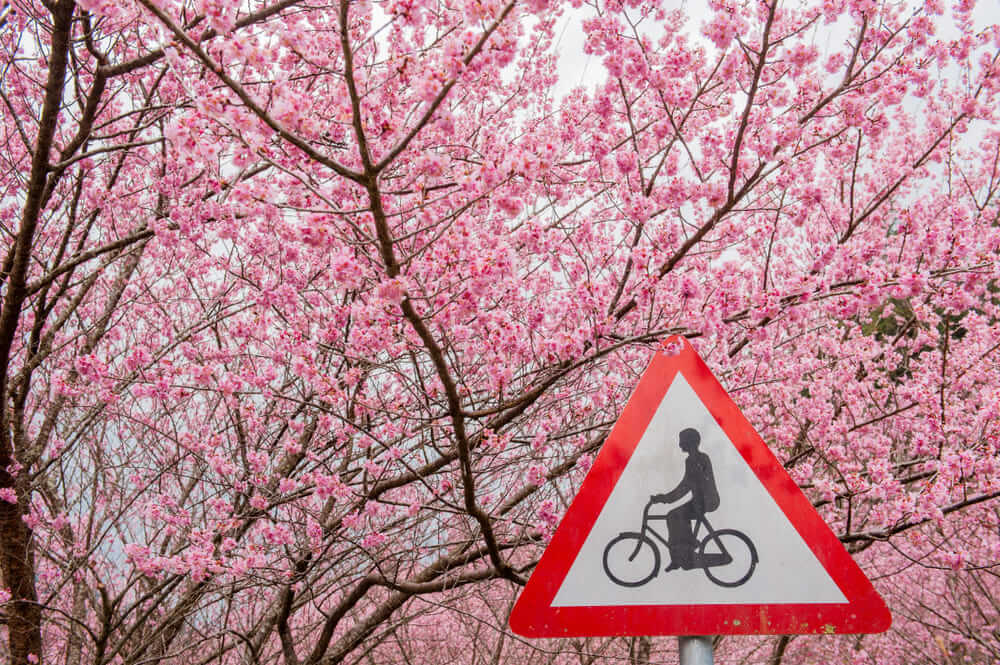
🌸 Spring (March–May): Flower Trails & Unpredictable Rains
Taiwan weather in Spring (March to May) is a popular season for cycling, thanks to its mild temperatures and vibrant blooming landscapes. Average temperatures range between 18–25°C (64–77°F), making it pleasant for both urban and countryside rides. Cherry blossoms, calla lilies, and golden trumpet trees line many trails, especially in regions like Yangmingshan, Wuling Farm, and the East Rift Valley.
However, Taiwan weather in spring can be highly unpredictable. You might experience sunshine, cloud cover, and sudden showers all in a single day. Late April to May marks the beginning of the plum rain season (Meiyu), which can bring several consecutive days of rain—often light but persistent. Wet roads and reduced visibility can be challenging, especially for less experienced riders.
In southern Taiwan, occasional föhn winds can cause sudden temperature spikes and dry conditions, especially in Tainan and Pingtung.
✅ Spring Cycling Tips:
🌦 Temperature Overview
Spring temperatures in Taiwan average between 18–25°C (64–77°F), offering a comfortable climate ideal for outdoor activities and cycling trips.
⚠️ Weather Characteristics
Taiwan weather during spring can change dramatically throughout the day—clear skies, overcast conditions, and sudden rain showers may all occur within hours.
From late April to May, the island enters the early stage of the Meiyu (plum rain) season, bringing light but persistent rainfall that can last up to two weeks.
In southern regions, occasional föhn winds may trigger brief periods of hot, dry weather, especially in areas like Tainan and Pingtung.
🚲 Cycling Risks
Wet and slippery roads reduce traction and visibility, increasing accident risk.
After rainfall, expect puddles, fallen leaves, and mossy patches—especially on riverside trails and park paths.
🎒 Recommended Gear
Pack light rain gear: A breathable rain jacket and waterproof shoe covers are must-haves.
Sun protection such as sunscreen, sunglasses, and UV sleeves.
🛣 Suggested Routes
Stick to urban riverside paths or flat suburban routes where detours are easy and terrain is forgiving.
Good options include:
Shuangxi Riverside Bikeway (雙溪河濱)
Tamsui River Left Bank (淡水河左岸)
Xindian River Trail (新店溪自行車道)
🧭 Travel Tips
Always check real-time Taiwan weather apps before departure (Windy, CWB, or AccuWeather).
Keep your itinerary flexible in case of sudden weather changes—rainy days may call for a shorter ride or indoor backup plans.
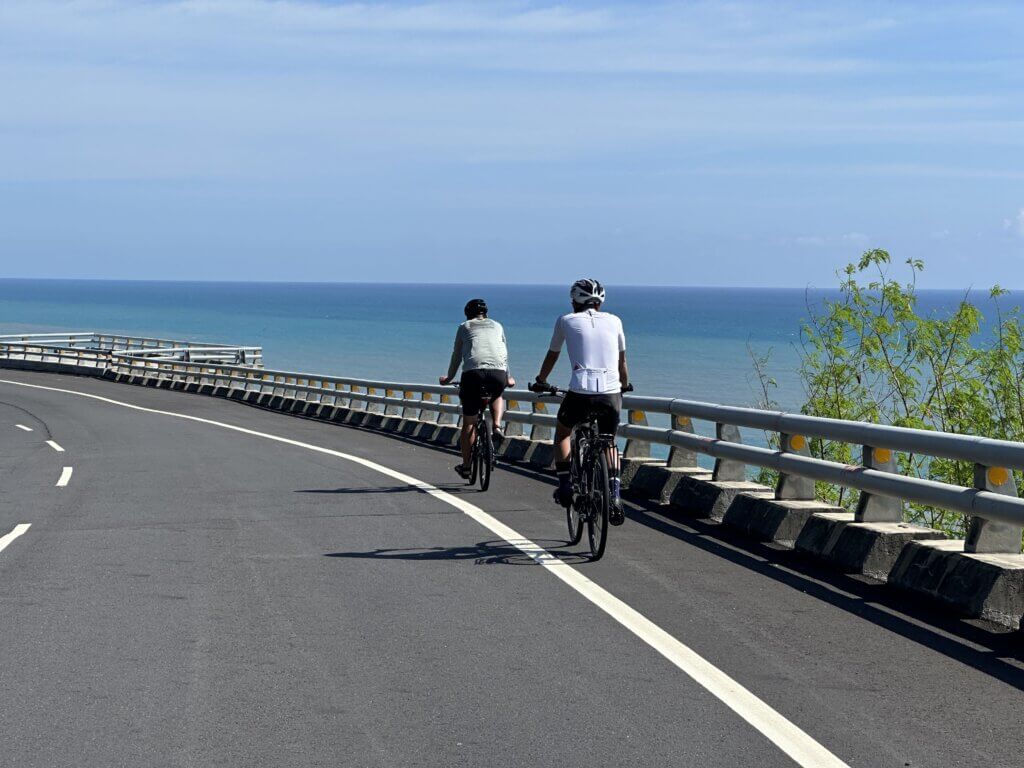
☀️ Summer (June–August): High Heat, Afternoon Storms & Typhoons
Taiwan weather in Summer (June to August) is hot, humid, and often unpredictable. Average daytime temperatures range from 28–40°C (82–100°F), with a high level of humidity that can make it feel even hotter.
In southern Taiwan and the east coast (particularly Taitung and Pingtung), dry föhn winds can cause sudden temperature spikes above 38°C (100°F). Staying hydrated and keeping your body cool becomes a top priority when cycling in these regions.
Sudden afternoon thunderstorms are common, especially in inland or mountainous areas. Skies may be clear in the morning and quickly turn stormy by noon.
Additionally, summer marks the peak of typhoon season in Taiwan (typically June to October). Typhoons can bring days of heavy rain, strong winds, and complete travel disruption. It’s essential to track Taiwan weather updates closely and postpone any rides if a storm is approaching.
👕 Recommended Gear & Precautions
- Wear light-colored, breathable clothing, a sun-protective hat, and UV-protective sleeves.
- Apply high-SPF sunscreen, and reapply frequently during long rides.
- Stay hydrated with plenty of water or electrolyte drinks to prevent heatstroke.
- Avoid long-distance rides in the early afternoon when the sun is strongest.
-
🌦 Temperature Overview
-
Daytime temperatures: 28–35°C (82–95°F)
-
High humidity can lead to heat exhaustion if not managed properly
-
-
⚠️ Weather Characteristics
-
Frequent afternoon thunderstorms, especially in inland areas
-
Typhoon season: June to October
-
Short but intense downpours can lead to flooding and slippery roads
-
-
🚲 Cycling Risks
-
Heatstroke, dehydration, and sunburn are serious risks
-
Sudden rainfall reduces visibility and road traction
-
Typhoons may cause fallen trees, landslides, and transportation shutdowns
-
-
🎒 Recommended Gear
-
UV-protective clothing, cooling sleeves, breathable helmet liner, sunscreen, sunglasses, two water bottles or hydration packs
-
Electrolyte tablets or sports drinks
-
Lightweight rain gear and waterproof phone case
-
-
🛣 Suggested Routes
-
Ride early in the morning or after 5 PM to avoid peak heat
-
Stick to coastal roads with sea breezes or urban riverside paths with nearby shelters
-
Good options include:
-
Taitung Pacific Coast (台東海岸)
-
Kaohsiung Love River Path (愛河自行車道)
-
Kenting (墾丁) seaside loops
-
-
-
🧭 Travel Tips
-
Check typhoon alerts daily via the Central Weather Bureau or Windy app
-
Plan short-distance rides with shaded rest stops and air-conditioned retreats
-
Always have a backup plan: if the weather turns dangerous, head to the nearest train station or shelter
-
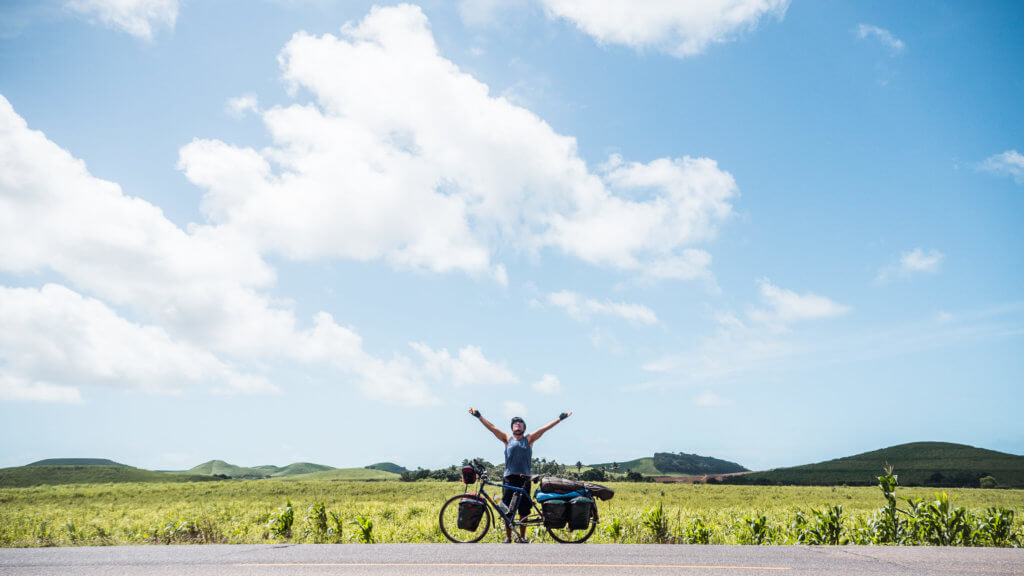
🍂 Autumn (September–November): The Golden Season for Cycling
Taiwan weather in Autumn (September to November) is widely considered the best for cycling.
With average temperatures ranging from 20–28°C (70–82°F), lower humidity, and stable skies, this season offers ideal conditions for both short scenic rides and long-distance challenges.
Typhoons may still appear in early September, but by mid-autumn, the island typically enters a period of dry, sunny, and wind-balanced Taiwan weather.
Roads are drier, the air is clearer, and the scenery—especially in central and eastern Taiwan—is at its most photogenic.
Whether you’re riding along rice paddies in Chishang, climbing mountain routes like Wuling, or completing a full round-island journey, autumn is the most cyclist-friendly season in Taiwan.
-
🌦 Temperature Overview
-
Daytime temperatures: 20–28°C (70–82°F)
Low humidity and steady conditions
-
-
⚠️ Weather Characteristics
-
Generally dry and sunny throughout most of Taiwan
Clear skies, crisp air, and excellent visibility for photos and scenery -
Early September may still see the tail end of typhoon season
-
-
🚴 Cycling Highlights
-
Ideal for multi-day trips, high-elevation routes, and remote coastal rides
-
Great time to attempt Wuling Pass, the highest paved road in Taiwan
Popular for cycling festivals and events, including round-island challenges
-
-
🎒 Recommended Gear
-
Light windbreaker for early mornings or descents in the mountains
-
UV protection still needed for midday rides
-
If your trip includes early September, it’s best to pack rain gear in case of unexpected showers.
-
-
🛣 Suggested Routes
-
East Rift Valley (花東縱谷): Chishang, Guanshan, Yuli—flat and scenic
Wuling Pass (武嶺挑戰): For advanced riders seeking high-altitude thrills
Sun Moon Lake (日月潭): Moderate terrain with panoramic lake views
-
Round-island cycling (環島): Autumn is the perfect season to go all-in
Four Extreme Points Route (四極點路線): A challenging route that takes you to Taiwan’s northernmost, southernmost, easternmost, and westernmost landmarks—ideal for experienced cyclists seeking a true endurance test
-
-
🧭 Travel Tips
-
Book accommodations early—autumn is a popular travel season
-
Always check early-September typhoon forecasts just in case
Consider joining a guided cycling tour or supported event during this season
-
❄️ Winter (December–February): Mild South, Wet North
Taiwan weather in Winter (December – February) varies dramatically depending on where you are. Northern Taiwan—including Taipei, New Taipei, and Keelung—is often cloudy, damp, and chilly due to strong northeast monsoons.
Temperatures can drop below 12°C (54°F), and frequent light rain or drizzle makes the roads slippery and visibility low.
In contrast, southern Taiwan remains dry, sunny, and comfortably warm, with daytime temperatures often reaching 22–26°C (72–79°F).This makes cities like Tainan, Kaohsiung, and Pingtung popular destinations for winter cycling. The Hengchun Peninsula, in particular, enjoys stable weather year-round and is known as a “spring-like land” even in the coldest months.
While high mountain roads may close due to snow or landslides, low-elevation coastal and riverside routes offer smooth and scenic rides throughout winter.
Read More: Best Time to Visit Taiwan: A Seasonal Travel Guide
-
🌦 Temperature Overview
-
Northern Taiwan: 10–16°C (50–61°F), wet and windy
-
Southern Taiwan: 20–26°C (68–79°F), sunny and dry
-
-
⚠️ Weather Characteristics
-
Frequent light rain in the north; cloudy skies dominate
-
Strong northeast monsoon winds, especially along the coast
South and southeast enjoy calm, sunny riding conditions
-
-
🚴 Cycling Highlights
-
Ideal for southern tours, lowland routes, and family rides
Great time for bikepacking around Tainan, Kaohsiung, and Kenting
-
Avoid high-altitude climbs—snow and road closures are possible
-
-
🎒 Recommended Gear
-
Windproof outer layer, arm warmers, and gloves (especially in the north)
-
Sun protection is still useful in the south
Pack layers—mornings and nights can be chilly even in warm regions
-
-
🛣 Suggested Routes
-
Kenting Coastal Loop (墾丁環線): Mild temperatures and ocean views
Tainan Cultural Bikeways (台南古城自行車道): Flat terrain and historic stops
-
Kaohsiung Riverside Path (高雄愛河與蓮池潭): Urban, scenic, and well-maintained
Taitung South Coast (台東南迴海岸): Stable weather and peaceful rural roads
-
-
🧭 Travel Tips
-
Check wind speed forecasts, especially for coastal rides
-
In the north, avoid riding after dark—damp cold and poor lighting reduce safety
In the south, winter is high season for tourism—book lodging in advance
-
Taiwan Cycling Seasons Overview
Season | Month | Highlights | Suggested Routes |
Spring | March – May |
|
|
Summer | June – August |
|
|
Autumn | September – November |
|
|
Winter | December – February |
|
|
Best Bike Routes in Taiwan by Season
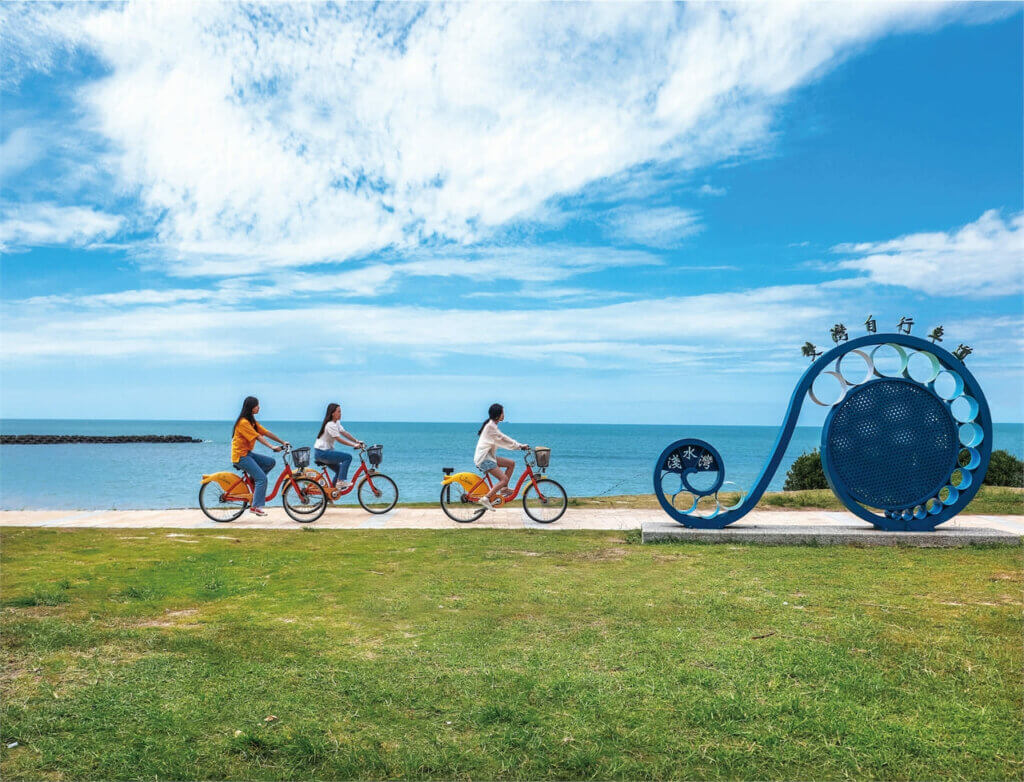
🏙 Northern Taiwan — Cool, Wet, and Best for Short Scenic Urban Rides
Northern Taiwan includes Taipei, New Taipei, Keelung, Taoyuan, Hsinchu, and Yilan.
These areas are strongly influenced by seasonal monsoons and mountainous terrain, resulting in cool, wet, and highly variable weather.
Taipei & New Taipei: These areas have relatively low sunshine hours and are mostly cloudy and rainy throughout the year, except during summer.
Taoyuan: mainly influenced by two major monsoon systems. Summers are generally sunny with frequent afternoon thunderstorms, while winters are windy but relatively dry.
Hsinchu: is located in a wind-exposed area due to its terrain. The northeast monsoon dominates in winter, bringing strong, dry, and cold winds. Rainfall is also significant during the plum rain season.
Yilan: is enclosed by mountains on three sides, making it prone to light, persistent drizzle in winter and during the plum rain season—hence the saying “Bamboo Wind and Orchid Rain.”
Overall, northern Taiwan is rainy and humid with rapidly changing weather, making it ideal for flexible cycling itineraries.
📍 Taiwan Weather Highlights by City:
Keelung:
Located on the windward side, Keelung sees constant winter drizzle due to northeast monsoons and orographic rainfall — earning it the nickname “Rainy Port”.
Taipei & New Taipei:
Low sunshine hours and frequent cloudy days outside of summer
Rain gear and warm layers are essential for spring and winter rides
Taoyuan:
Influenced by both monsoon systems; summer is hot and stormy with frequent afternoon showers,
Winter is dry but windy.
Hsinchu:
Known as Taiwan’s “Windy City”, Hsinchu faces strong, dry winter winds from the northeast.
Rainfall peaks during plum rain season.
Yilan:
Surrounded by mountains in a basin-like topography, it’s a classic windward region
Yilan is famous for long periods of drizzle during winter and plum rain season — earning the poetic nickname “Bamboo Wind and Orchid Rain”.
✅ Cycling Tips:
Plan flexible routes to avoid heavy rain or strong winds.
Opt for urban and riverside paths where shelter and transport access are easy.
Recommended Gear: Waterproof panniers, rain jacket, windproof outerwear, spare clothes.
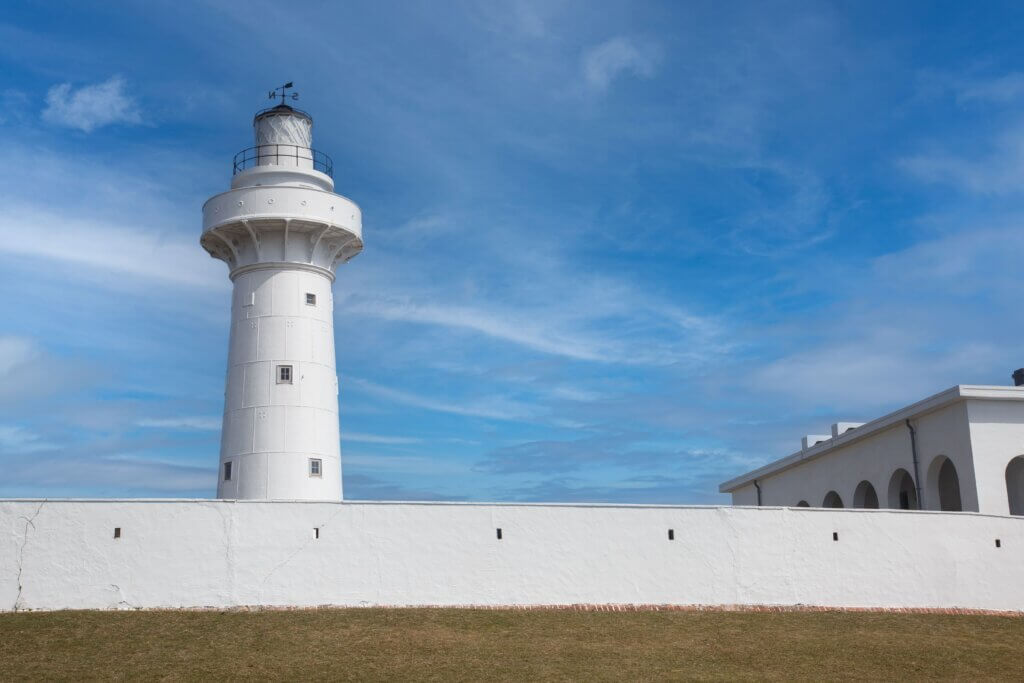
🌞 Central & Southern Taiwan — Stable and Sunny, Ideal for Multi-Day Cycling
Central and southern Taiwan includes Miaoli, Taichung, Changhua, Yunlin, Chiayi, Tainan, Kaohsiung, and Pingtung. These regions have a subtropical climate with hot, wet summers and cool, dry winters — ideal for year-round outdoor cycling with clear seasonal shifts.
Miaoli and Taichung have varied terrain, with cooler climates in the mountainous areas. Rainfall is mostly concentrated in summer, while winters are cold and damp.
Changhua is sheltered by the Central Mountain Range, with most of its rainfall occurring in summer.
The overall climate is mild.
Nantou is surrounded by mountains and has a humid climate, with frequent afternoon thunderstorms in summer and drier conditions in autumn and winter. Yunlin is hot and humid, with most of its rainfall occurring during the summer.
Southern Taiwan has a warm climate year-round, with clearly defined wet and dry seasons.
Chiayi often experiences low temperatures in winter due to radiative cooling, while in summer, afternoon thunderstorms are frequent.
Tainan, Kaohsiung, and Pingtung receive abundant sunshine, with rainy summers and dry winters. The Hengchun Peninsula, moderated by sea breezes, has a mild climate and is often described as having “spring-like weather all year round.
Overall, central and southern Taiwan enjoy stable and comfortable weather, making them ideal for outdoor activities and travel.
📍 Taiwan Weather Highlights by City:
Miaoli & Taichung:
Mixed terrain with hilly and mountainous areas; cool in winter, rain mostly in summer.
Great for low-elevation rides during spring and fall.
Changhua:
Sheltered by the Central Mountain Range, rain is mostly concentrated in summer.
The mild and consistent weather makes it suitable for cycling year-round.
Nantou:
Mountainous and humid, with summer thunderstorms and dry, cool autumns and winters.
Ideal for lakeside and hill routes.
Yunlin:
Mostly flat plains, hot and humid.
Watch for intense summer rain and heat.
Chiayi:
Cold mornings in winter due to radiative cooling; summer brings frequent afternoon storms.
Prepare for fast-changing weather.
Tainan, Kaohsiung, Pingtung:
High annual temperatures, abundant sunshine.
Wet season falls in summer; dry, clear winters offer perfect riding conditions.
Hengchun Peninsula:
At Taiwan’s southern tip, this area enjoys steady, warm weather year-round due to oceanic breezes — earning its title as the “Land of Eternal Spring”.
✅ Cycling Tips:
-
In summer, avoid riding at midday. Sun protection and hydration are crucial.
-
Winter is the best time for long-distance cycling, especially in the Chiayi → Tainan → Kaohsiung → Pingtung
-
Recommended Gear: Sun-protective clothing, water bottles or hydration pack, rain jacket (summer), lightweight outerwear (cool mornings).

🌊 Eastern Taiwan — Stunning Scenery, Strong Winds, and Sparse Facilities
Eastern Taiwan includes Hualien and Taitung. With warm weather year-round and high rainfall, this region offers breathtaking coastal and mountain views, making it a dream destination for cycling enthusiasts.
However, strong winds and limited roadside facilities require careful planning.
Taitung is influenced by land-sea temperature differences, with summer temperatures often exceeding 30°C and winter temperatures around 20°C.
It is also one of the regions most directly affected by typhoons, with most of the rainfall concentrated in summer, while the weather is generally sunny.
The Hualien – Taitung region offers breathtaking mountain and ocean views, making it a dream destination for cyclists and a perfect spot for travel and outdoor activities.
However, strong winds and limited roadside facilities require careful planning.
📍 Taiwan Weather Highlights by City:
-
Hualien:
-
Narrow and mountain-lined, with large day–night temperature swings.
-
Frequent summer afternoon showers; cool and clear in spring and fall.
-
Winter rides are possible, though northeast winds can affect coastal routes.
-
-
Taitung:
-
Sunny and warm all year.
-
Summer is hot and rainy, but wind speeds are generally lower than on the west coast.
-
Winter is dry and mild, offering the most stable riding weather.
-
Places like Taimali and Jinlun are dubbed “Taiwan’s Little Hawaii” and are ideal for coastal cycling.
-
✅ Cycling Tips:
Best seasons: Autumn and winter, with cooler temps and less rainfall.
In summer, ride early or late to avoid heat. Be prepared for sudden rain and UV exposure.
Recommended Routes:
East Rift Valley (e.g., Ruisui, Chishang, Guanshan): Flat, scenic farmland and mountain views.
Pacific Coastal Highway: From Fengbin to Chenggong, Donghe to Jinzun—stunning but some sections prone to rockfalls and limited visibility.
Required Gear: Sunscreen, water bottles, light rain gear, rear lights (some coastal sections are dim).
🗺️ Taiwan Weather Overview by Region (North to South)
Region | Features | Recommended Cycling | Important Notes |
Northern Taiwan |
|
| Bring proper rain gear |
Central & Southern Taiwan |
|
| Watch for heat; stay hydrated and use sun protection |
Eastern Taiwan |
|
| Be aware of strong downslope winds and typhoons |
🎒 Recommended Cycling Gear by Taiwan Weather Condition
| Taiwan Weather Condition | Recommended Gear |
|---|---|
| Unstable Weather (Spring / Plum Rain Season) |
Lightweight rain jacket, waterproof shoe covers, rain cover for backpack, spare gloves, quick-dry clothing |
| High Heat (Summer) |
UV-protective sleeves, sunglasses, well-ventilated helmet, electrolyte drinks, UV-resistant jacket |
| Cold Fronts or Mountain Rides (Winter) | Windproof jacket, arm and leg warmers, thermal cap, neck gaiter, touchscreen gloves, heat packs |
| Sudden Rain | Reflective rain jacket, rear light, waterproof phone pouch, backup route plan (include train access) |
| Long-Distance Trips | Spare clothing, power bank, flat tire repair kit, weather apps, energy snacks or gels |
🧢 Gear and Clothing Tips for Taiwan’s Changing Weather
👕 Clothing Strategy: Windproof, Sun-Protective, and Breathable in Layers
For cycling in Taiwan, we recommend a layered “corn-style” dressing system to adapt to ever-changing weather conditions.
Due to Taiwan’s unpredictable mix of heat, humidity, cold fronts, and heavy rain, flexible clothing choices are essential.
- Outer layer: Windproof and water-resistant jacket
- Middle layer: Moisture-wicking T-shirt
- Inner layer: Breathable base layer
In summer, wear UV-protective sleeves and a sun cap to shield against intense sunlight.
In autumn and winter, add knee warmers and a scarf or neck gaiter to deal with large temperature swings between day and night.
Taiwan receives a large amount of rainfall annually, so riding in wet weather can be especially challenging for cyclists.
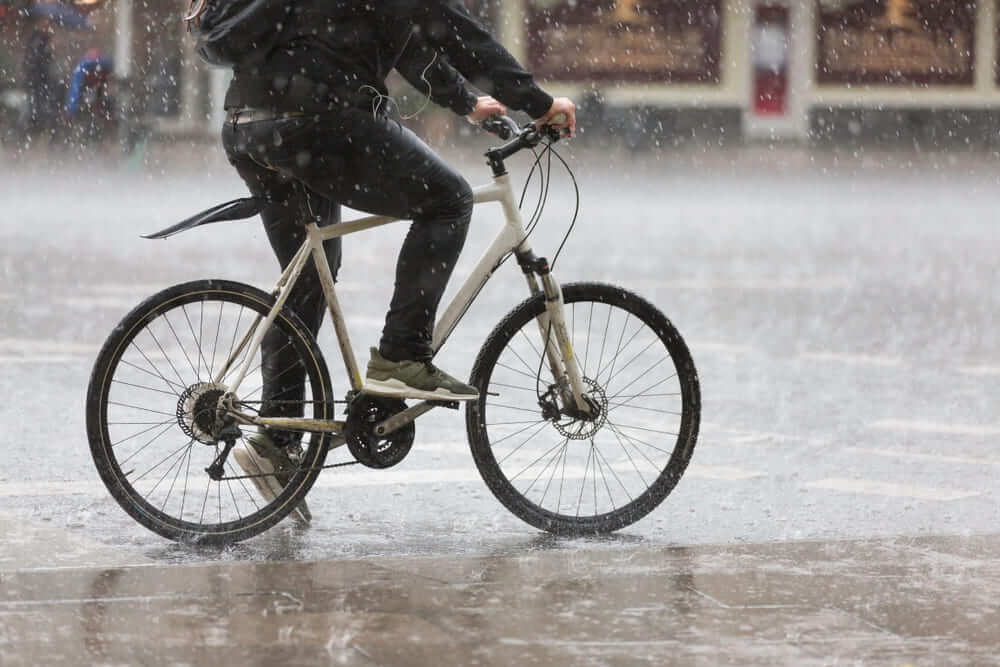
🎒 Gear Checklist: Rain Protection, Dry Storage, and Backup Clothing
Taiwan’s climate brings spring drizzles, plum rain, afternoon thunderstorms, typhoons, and cold winter rain.
To stay comfortable and safe, pack lightweight rain jackets, rain pants, and waterproof shoe covers.
Use waterproof phone pouches and rain covers for bags to protect your belongings.
Bringing an extra set of clothes is also highly recommended. If you get soaked, you can change at a rest stop and stay warm and dry for the rest of your ride.
💧 Hydration & Energy Tips for Long Rides
Hydration is crucial year-round in Taiwan Weather.
Drink water every 30 minutes, and for longer rides, supplement with sports drinks containing electrolytes.
For energy boosts, bring along bananas, energy bars, or quick local snacks like oden (Japanese-style hot pot).
In summer, avoid iced drinks — they may upset your stomach. Room-temperature beverages are safer and easier on digestion during physical activity.
🌪️ Avoiding Taiwan’s Extreme Taiwan Weather Risks
Taiwan’s subtropical island climate is heavily influenced by monsoons and the ocean. Between May and October, cyclists often encounter extreme Taiwan weather conditions such as plum rain, afternoon thunderstorms, and typhoons. These not only disrupt travel plans but also pose serious safety hazards. Awareness and preparation are essential for a safe and successful cycling journey.

🌀 Typhoon Season (June–October): Advance Planning & Real-Time Tracking Are Key
-
🛰 How to Track Typhoons
Taiwan Weather experiences frequent typhoons, with an annual average of 3–5 systems either making landfall or passing nearby. Before your trip, monitor typhoon activity using trusted tools:-
Windy.com(for visual storm forecasts)
-
Weather alert apps like AccuWeather or Taiwan’s Weather+ (氣象達人)
-
🔍 What to Check Before Departure
-
Typhoon center location, projected path, and wind radius
-
Potential indirect effects: strong winds, rough seas, transit delays
-
If any official warnings are issued, cancel or reschedule your ride immediately—never attempt to cycle in typhoon conditions
-
-
⚠️ Safety Reminders
Before and after a typhoon, avoid riverbanks and mountain areas prone to flooding, landslides, or falling trees. Even post-storm, check for fallen rocks, damaged roads, or interrupted transport routes before proceeding.
🌧 Plum Rain Season (May–June): Don’t Let Days of Rain Ruin Your Trip
🌧 The Safety Risks of Sudden Rain and Slippery Roads
Plum rain arrives in the form of long-lasting frontal systems, causing consecutive days of moderate to heavy rainfall. Hazards include:Waterlogged roads leading to poor braking and tire grip
Leaves, moss, and mud increasing slip-and-fall risk
Prolonged exposure to damp and cold, causing fatigue and lowered concentration
🧥 Recommended Rain Gear
Lightweight rain jacket: Choose a full-zip design for easy removal and ventilation
Waterproof shoe covers: Keep your shoes and feet dry during long wet rides
Waterproof bags and phone pouches: Protect valuables and navigation tools
Rear lights and reflective gear: Improve visibility in low-light, rainy conditions
💡 Pro Tips
During the plum rain season, opt for riverside bike paths or short urban rides where you can easily find shelter. Reduce daily mileage and choose routes with nearby indoor rest options in case you need to cut the ride short.
🚴♀️ Taiwan's Top Cycling Routes by Season
Taiwan offers a diverse mix of landscapes and climates—ranging from towering mountains to scenic coastlines, and from riverside urban paths to peaceful country backroads. Each region has its own best time for cycling. By choosing your destination based on seasonal weather patterns, you can avoid extreme heat and heavy rain while enjoying the most breathtaking views and most comfortable riding conditions.
Here are some of the most popular cycling routes across Taiwan, along with their recommended seasons to help you plan the perfect trip without any surprises:
🚴 Recommended Routes × Best Seasons Chart
| Route | Region | Best Season | Reasons & Notes |
|---|---|---|---|
| Taroko Gorge | Hualien | Autumn, Winter | Dry and stable weather with stunning canyon views; avoid typhoons and rockfalls |
| East Rift Valley | Hualien, Taitung | Spring, Autumn, Winter | Flat and scenic with steady weather—ideal for long, leisurely rides |
| Kenting Coastal Loop | Pingtung | Winter, Spring | Warm and spring-like year-round; a top winter cycling escape |
| Sun Moon Lake Loop | Nantou | Autumn, Winter | Cool and dry with lakefront scenery—perfect for lightweight day trips |
| Tamsui River Left Bank | Taipei, New Taipei | Spring, Autumn | Riverside greenery and varied scenery; pleasant weather for beginners |
| Jiannan Farmland Routes | Chiayi, Tainan | Winter, Spring | Flat, beginner-friendly roads; dry and comfortable winter weather in the south |
| Wuling Climb Challenge | Nantou, Hehuanshan | Summer, Autumn | High-altitude route—avoid winter snow; best for experienced riders in stable weather |
| Alishan Highway | Chiayi | Autumn | Cool and dry with lush forest views—ideal for multi-day climbs |
| West Coast Round-Taiwan | Taoyuan–Kaohsiung | Autumn, Winter, Spring | Mild weather, flat terrain—popular route for beginner-friendly island tours |
✅ Pro Tips:
In summer, avoid riding during midday hours; hydration and sun protection are essential.
In autumn and winter, prepare for large temperature swings between morning and night—bring windproof and thermal layers.
For mountain routes, watch for rockfall hazards, rapid weather changes, and long distances between rest stops.
FAQ: Taiwan Weather & Biking
Q1: Do typhoon and plum rain seasons affect cycling in Taiwan?
Yes, they do—significantly. Due to Taiwan’s geographic location, the typhoon season (July–September) and plum rain season (May) are the two rainiest periods of the year.
Typhoons bring heavy wind and rain, often resulting in closed roads and suspended cycling routes for safety reasons. During plum rain season, days of continuous drizzle can make roads slippery and increase accident risks.
👉 It’s best to avoid these periods and plan your trip during more stable weather seasons.
Q2: What should I do if I encounter heavy rain or strong wind while cycling?
If you’re caught in heavy rain or gusty wind, seek shelter at the nearest convenience store, train station, or building overhang.
Do not continue riding in hazardous conditions, as visibility and road traction can be severely compromised.
👉 Always check the weather forecast before you ride, and adjust your plan accordingly to stay safe.
Q3: What’s the best season for cycling in Taiwan?
Autumn (September–November) is widely considered the best time for cycling in Taiwan.
The weather is stable, temperatures are pleasant, and the scenery is at its most vibrant—making it the golden season for bike travel.
Spring is also a good option for beginner riders who prefer shorter trips, as it avoids both summer heat and heavy rainfall.
Q4: Do I need to wear a down jacket for winter rides in Taiwan?
No. Down jackets aren’t recommended for cycling, as they trap moisture and don’t breathe well. Instead, follow a layered system:
Sweat-wicking base layer
Insulating mid-layer
Windproof outer shell
This allows you to adjust your clothing easily based on temperature and activity level.
Q5: Is it really possible to cycle in southern Taiwan year-round?
Almost always—yes. Southern Taiwan, especially Tainan, Kaohsiung, and Hengchun, has mild, dry winters that are ideal for riding.
While summer is hot, most rainfall comes in short bursts in the afternoon.
👉 Ride early in the day to avoid the heat. In fact, many northern cyclists head south in winter for exactly this reason.
✅ Final Thoughts
Understanding Taiwan weather is key to a smooth and enjoyable cycling trip.
With its dynamic climate and rich geography, each season in Taiwan comes with its own beauty and challenges. For first-time visitors, researching seasonal weather, bringing the right gear, and keeping a flexible mindset will help you fully enjoy your two-wheeled journey around the island.
References


